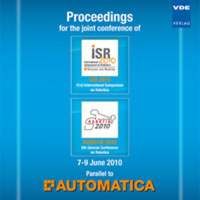Development of a highly integrated torque sensor concept for drive units of a humanoid robot
Konferenz: ISR/ROBOTIK 2010 - ISR 2010 (41st International Symposium on Robotics) and ROBOTIK 2010 (6th German Conference on Robotics)
07.06.2010 - 09.06.2010 in Munich, Germany
Tagungsband: ISR/ROBOTIK 2010
Seiten: 6Sprache: EnglischTyp: PDF
Persönliche VDE-Mitglieder erhalten auf diesen Artikel 10% Rabatt
Autoren:
Albers, Albert; Frietsch, Markus; Sander, Christian; Ottnad, Jens (IPEK - Institut für Produktentwicklung, Karlsruher Institut für Technologie (KIT), Kaiserstraße 10, 76131 Karlsruhe, Germany)
Inhalt:
Humanoid robots are a prime example for complex mechatronic systems. During the development process of such systems big challenges arise from interaction between different involved domains. In this article the development of the torque sensor concept for the next generation of the humanoid robot ARMAR - the demonstrator system of the collaborative research centre 588 "learning and cooperating multimodal robots" - is presented. The objectives of the development of humanoid and industrial robots strongly differ from each other. Amongst others this is due to the fact that humanoid robots are designed for safe cooperation with humans in their natural environment e.g. in the kitchen, while industrial robots still work more or less separated from their "human colleagues". Aspects like humanlike appearance and motion space are very important to provide a wide acceptance of these machines. Especially elderly people, who could benefit a lot from a robot’s help, are not used to cooperate with such systems and sometimes they are even afraid. As a consequence of close cooperation between robots and humans strong safety requirements have to be considered. For example the applied forces of every joint have to be measured and controlled to prevent injuries of the human. In order to implement an efficient development and manufacturing process of the system a highly modular concept for all drive units - consisting of motor, gear box and sensor - is necessary. The similar units can then be used in different joints like the elbow or shoulder joint. To realize a humanlike appearance, which is a big challenge regarding the power density of a human, such a modular drive unit has to be extremely compact to fit into a humanlike design space. Therefore the dimensions of the torque sensor also have to be minimized. Commercial sensor systems provide excellent accuracy and sensitivity but the possibility for the integration of these sensors is strongly limited caused by their geometrical dimensions and weight. Depending on the design of the force transmission, different sensor concepts are possible. In the current generation of ARMAR, for example, the forces applied to the forearm are determined by measuring the tensile forces in wire ropes, which drive the elbow joint. An alternative solution for this concept has to be found because of the planned replacement of these wire ropes in the next generation of ARMAR. An example of a successful application of customized torque sensors is the lightweight robot arm designed by the DLR. In order to realize an optimal controllability of the drive units, the sensor should be located at the drive-side. This minimizes the influence of friction and backlash within gearbox and bearings on the sensor signal. A lot of further boundary conditions e.g. guiding of cables, limited design space or measurement of angles cannot be considered separately. Therefore the basic sensor concepts and the mechanical design have to be developed together. For our application scenario, strain gauge based concepts turned out to be the most promising solutions. In this article different sensor designs including hollow and solid shafts are discussed and evaluated regarding e.g. modularity, dimension, weight and the impact on the joint design. To accelerate the development process and to reduce the number of design iterations, different FE-analyses were conducted. In order to validate the results of the simulations, a test-bed equipped with customized and a commercial torque sensor was developed and built. The commercial sensor is used simultaneously to validate the results gained from the customized sensor. By using this test-bed, representing a typical drive unit of the humanoid robot, static and dynamic load cases can be applied. Thus it is possible to determine properties like accuracy and sensitivity of the designed sensors to find the optimal tradeoff between the already named boundary conditions. As a result of this process a modular torque sensor with a low "weight to maximum torque"-ratio was developed. Also the achieved sensitivity and accuracy is comparable to a commercial sensor and outperforms the requirements for a humanoid robot. This single sensor can be used for a wide maximum torque range and can hence be integrated in different joints of the next generation of ARMAR without any manipulation of the design.


